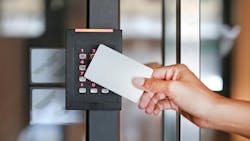Get the Most Out of Your Security Technology Investment
Key Highlights
- Regular third-party security assessments help identify vulnerabilities and benchmark your building against similar facilities.
- Emerging technologies like AI, cloud security, blockchain, and integrated systems are transforming building security practices.
- Focus on user experience with smart credentials and sophisticated visitor management to streamline access and improve safety.
- Security should complement operational procedures and physical design, not replace them, ensuring comprehensive protection.
- Stay informed about industry standards and resources from trusted organizations to guide security improvements.
Security is a moving target, not a one-and-done situation. What worked for your building today may not adequately prepare you for tomorrow. Emerging technologies can help you stay up to date—and so can best practices. Check out our guide to updating your security tech to make sure you’re keeping up with the other buildings on your block.
Identify the Gaps in Your Current Practices
Finding opportunities to upgrade starts with understanding where you fall short, explained Bill Sako, vice president and senior security consultant for Telgian Engineering & Consulting. Ideally, each building should receive a security assessment from a third-party consultant on at least an annual basis. This consultant should benchmark you against similar buildings and similar clients to determine whether your current practices and technologies are effective and where you can do better.
The consultant may even suggest doing a dry run to see how well they can penetrate your defenses, added Patrick Milnamow, senior security consultant for Affiliated Engineers Inc. (AEI). “It’s difficult when you’re a facility manager because your staff knows you there, but third-party utilization is big on that. Do an exterior to interior walk, see how far you can get, and we’ll step through that and address each one of [the issues],” he said. “For us, in testing, I introduce myself and try to get in as far as I can from the front entry. There are always side doors that are unchecked and unmonitored or don’t have cameras on them, so always check those. Door hardware, [I look for] whether it’s eroded from the exterior and how easily I can gain access to the back end.”
As you comb through the recommendations from your consultant, think about what you’re trying to achieve with your security. “Does the technology you’re implementing help you achieve that and give you room for expansion, or does it lock you in, and at some point in time you’re going to have to change all of your infrastructure?” asked Robert Gaulden, go to market director for Allegion’s multifamily access business. “Look for companies that have open architecture and the ability to work with multiple partners.”
6 Security Tech Developments to Investigate
Once you know where the gaps are, you can move to fill those gaps with strategies and products that can help you let the right people in while keeping threats out. Consider these six developments in security technology and best practices as you review your consultant’s recommendations.
1. Artificial intelligence and machine learning. These technologies are making threat detection smarter and simpler for human reviewers. “It’s being used on literally every project we work on now,” Sako said.
2. Cloud-based security systems with zero-trust architecture. Storing your information on the cloud means you don’t have to set up and maintain your own data storage, Sako said.
3. Blockchain technology for data security. This technology has been used for secure data storage and identity management, Sako said. Most people who are familiar with blockchain technology are aware if it’s in the context of securing transactions, but it can also help with regulatory compliance, he said.
4. Integrating security systems. Older technologies required you to install and manage multiple disparate systems for different aspects of your security system, Sako said. “Today, they’re being integrated into a single platform, which is huge,” Sako added.
5. A focus on the user experience, enabled by smart credentials. People who come to your building want to have a positive, seamless experience, said Rob Lydic, president of Wavelynx. On the back end, facility managers want to understand how many people are using building amenities, and which ones. “Commercial real estate entities are realizing that access control—how am I coming into the building, who’s in the parking garage, who’s on what floor, who’s using the elevators and restrooms—all of those things are now foundationally tied to credentialing,” Lydic said. “It’s the only real measurement of who’s coming in the building and how much are they using it.”
6. More sophisticated visitor management systems. “A lot of facility managers are trying to handle this with a concierge or security guard at the front, but now they’re reevaluating,” Milnamow said. For example, your building may receive a lot of packages, which would tie up a human concierge’s time and energy. A smart access control system like ButterflyMX takes some of the responsibility out of the concierge or guard’s hands and alleviates the load.
Top Takeaways for Securing Buildings
Technology can greatly lessen the load when it comes to security, but it can’t be the only solution, Milnamow said.
“Security systems are meant to assist the user with detecting and denying unauthorized personnel,” Milnamow added. “We can’t rely solely on technology. It’s complementary to your operations, procedures, physical design and environment, and life safety code.”
At the same time, you need to make sure you’re using a level of protection similar to other buildings like yours, Sako added.
“You have to kind of keep up with the Joneses if you want to avoid liability,” Sako said. “It’s been a truism of security design for the past 30 to 40 years. If there are vulnerabilities out there, you have to do something about protecting people from those. Seeing what other people are doing is good because it helps you see how people developed a solution to a problem that might be in the lobby, as an example.”
Each building is different, said Ken Cook, director of education, safety, and advocacy for Allegion, and many people who have security responsibilities aren’t necessarily security experts, and it’s hard for any one person to know everything. Look for resources from trusted sites, such as schoolsafety.gov or passk12.org for schools. Partner Alliance for Safer Schools (PASS), a security-focused organization that helps schools discover areas for improvement has developed checklists, guidelines, and white papers that provide a road map for school administrators and security directors. Other resources exist for other building types.
Embrace solutions that can do double duty with both security and convenience, Gaulden added.
“I’m not sure security has to be one-threaded anymore,” Gaulden said. “The implementation of these technologies that are security-based, like access control or video, have other purposes that can help with operational efficiency or the experience. The ability to provide a secure and safe environment while still giving the experience you want is something the industry is starting to rally around. As you look to apply security to your building or portfolio, ask the additional questions—what else can be a byproduct of implementing this? I think you’ll be pleasantly surprised.”
About the Author
Janelle Penny
Editor-in-Chief at BUILDINGS
Janelle Penny has been with BUILDINGS since 2010. She is a two-time FOLIO: Eddie award winner who aims to deliver practical, actionable content for building owners and facilities professionals.

